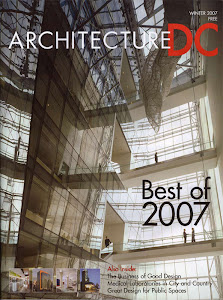 I admit that I've always had mixed opinions about the work of Michael Graves. While his objects for companies such as Alessi and Target are playful and, especially in the case of the latter, provide consumers access to design objects at affordable prices, their appeal derives from their form first and foremost, with function seemingly secondary. In fact, like many of his PoMo colleagues, Graves' work explores the nature forms in the development of architecture. Grave's intentionally plays with the scale and proportions of the building elements. Individual bricks recede into accentuated walls and are reinterpreted as large scale building blocks. Small, square windows are but mere panes in the caricatured, multi-pane windows. The effect are buildings which seem more like basic building blocks, simple geometric forms, placed innocently among the typical city architecture. From his architecture to his product design, there is a toy-like quality to his work. There are times that this approach may seem inappropriate, such as in the case of the Annex to the E. Barry Prettyman Courthouse, where the watered-down aesthetic lacks the sincerity one might expect from a federal building, and gives the building a sense of naivety. There is a question of the genuineness of the style and the architecture that one must confront. There is a certain sense of classicism, but reinterpreted in such a way as to feel nostalgic and contrived.
I admit that I've always had mixed opinions about the work of Michael Graves. While his objects for companies such as Alessi and Target are playful and, especially in the case of the latter, provide consumers access to design objects at affordable prices, their appeal derives from their form first and foremost, with function seemingly secondary. In fact, like many of his PoMo colleagues, Graves' work explores the nature forms in the development of architecture. Grave's intentionally plays with the scale and proportions of the building elements. Individual bricks recede into accentuated walls and are reinterpreted as large scale building blocks. Small, square windows are but mere panes in the caricatured, multi-pane windows. The effect are buildings which seem more like basic building blocks, simple geometric forms, placed innocently among the typical city architecture. From his architecture to his product design, there is a toy-like quality to his work. There are times that this approach may seem inappropriate, such as in the case of the Annex to the E. Barry Prettyman Courthouse, where the watered-down aesthetic lacks the sincerity one might expect from a federal building, and gives the building a sense of naivety. There is a question of the genuineness of the style and the architecture that one must confront. There is a certain sense of classicism, but reinterpreted in such a way as to feel nostalgic and contrived.
To me, Graves' work is sort of like the architectural equivalent of a topiary: simple and elemental in form, meticulously fashioned, and innately formal; but does it move me? Does it warrant further inspection, or is it a simple object, best viewed from a far?
There are times, however, that this approach, this style, as it were, does make sense. Take, for instance, Grave's design for St. Coletta of Greater Washington, a school serving children and adults with cognitive disabilities. Situated at the edge of the Lincoln Park neighborhood just steps from the Stadium-Armory metro station, the building does many things very well. The scale and form reflect the residential nature of the houses across the street. The colors are vivid and playful -- a welcome respite from the mammoth cream colored Armory and RFK stadium that loom nearby. And the building's forms in this instance are very appropriate, and thereby successful, appearing themselves as a simple assembly of basic building blocks. It is a building whose form is comprehensible on the most basic level. This is especially significant when you realize that students at the school suffer from mental retardation and autism. The building's design in this case is very intentional. Colors, shapes, and patterns are chosen to identify what the architect refers to as 'houses' that are organized around a central outdoor space referred to as 'the village green'. These elements help students at the school identify and relate to their settings. In other words, there is an intrinsic function to the form of this building, one which helps to instills confidence and comfort. The thought and attention that went into the design is indeed commendable.
While plans are up in the air regarding the fate of the RFK Stadium site (standby for an upcoming post), it is certain that change is on the horizon for this area. St. Coletta stands as a welcome cornerstone in this emerging part of the city.
For more information on St. Coletta of Greater Washington, please visit their website and read the National Building Museum interview with the architect.
Friday, March 14, 2008
Where Graves Makes Sense
Subscribe to:
Post Comments (Atom)









No comments:
Post a Comment